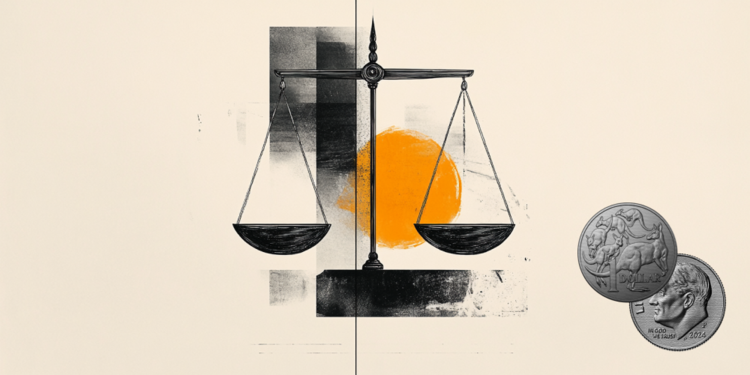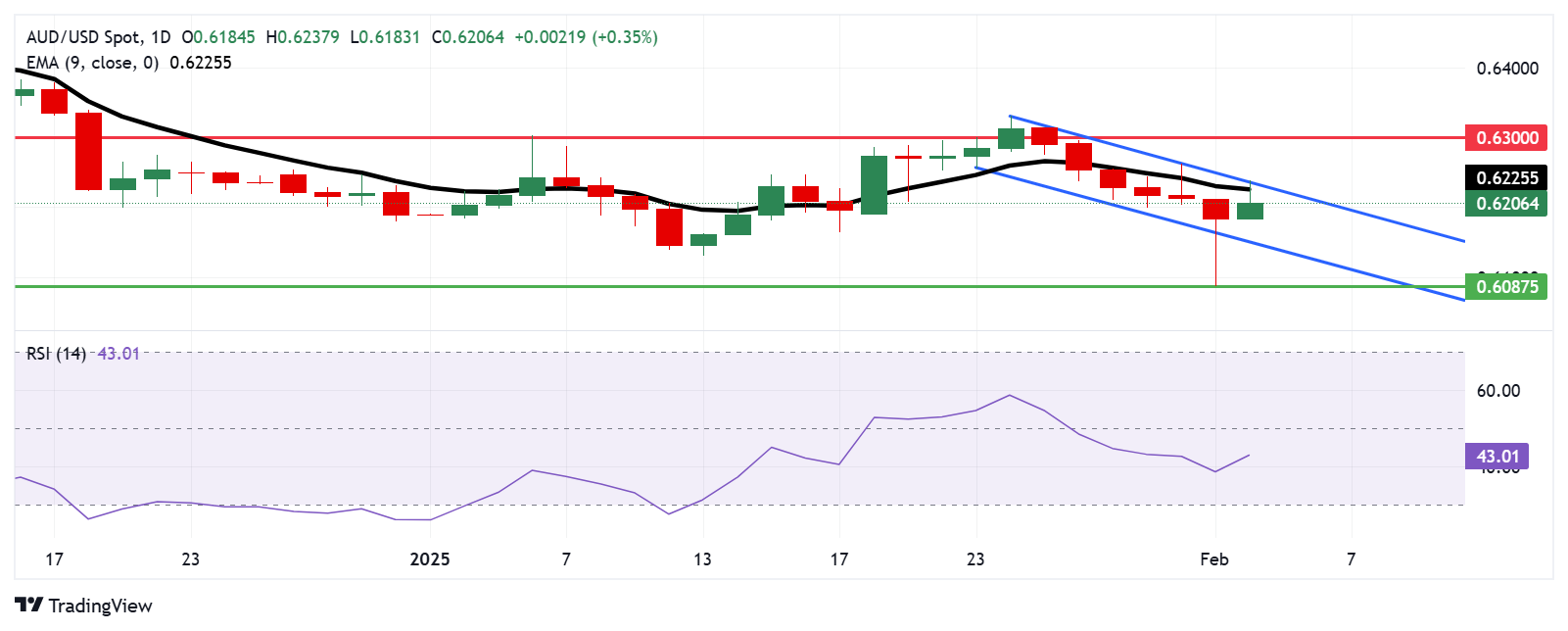Products You May Like
- The Australian Dollar could struggle as China is due to be hit with a 10% tariff later in the day.
- Traders monitor the development surrounding the tariff deal with China.
- Trump would suspend his tariffs after both countries agreed to send 10,000 soldiers to the US border to prevent drug trafficking.
The Australian Dollar (AUD) rebounds on Tuesday, ending its six-day losing streak as the AUD/USD pair rises amid a weakening US Dollar (USD). The USD depreciated after US President Donald Trump announced late Monday that he would pause tariffs on Mexico and Canada. However, market volatility remains a concern as investors closely watch developments in the ongoing tariff negotiations with China, Australia’s key trading partner. China is due to be hit with across-the-board tariffs of 10% that begin at 05.00 GMT on Tuesday. On Monday afternoon, Trump stated that he would likely speak with China within the next 24 hours. He also warned, “If we can’t reach a deal with China, the tariffs will be very, very substantial.”
President Trump stated that he would suspend steep tariffs on Mexico and Canada after their leaders agreed to deploy 10,000 soldiers to the US border to combat drug trafficking. The tariffs on Mexico and Canada have been postponed for at least 30 days. This decision comes just two days after Trump imposed 25% tariffs on Mexican and Canadian goods and 10% tariffs on imports from China.
According to the Financial Times, Chinese exporters are intensifying their efforts to offshore production in response to Trump’s tariffs. Manufacturers in China are accelerating plans to relocate production to other countries, including the Middle East, to avoid US tariffs. Other tactics being considered include passing the increased costs onto US consumers and exploring alternative markets.
The AUD may lose its ground due to the increased likelihood that the Reserve Bank of Australia (RBA) could consider a rate cut in February. The RBA has maintained the Official Cash Rate (OCR) at 4.35% since November 2023, emphasizing that inflation must “sustainably” return to its 2%-3% target range before any policy easing. A Westpac’s note suggests that confidence in the RBA starting to cut rates at its February 18 Board meeting is expected to remain steady this week. Westpac continues to forecast 100 basis points of rate cuts in 2025, while market expectations are slightly more conservative.
Australian Dollar appreciates due to improved risk sentiment
- The US Dollar Index (DXY), which measures the US Dollar’s value against six major currencies, stabilizes around 108.70 at the time of writing after giving up most of its gains in the previous session.
- The White House announced late Monday that US President Donald Trump signed an executive order to initiate the creation of a government-owned investment fund, according to Reuters. This fund could allow the US to profit from TikTok if an American buyer is secured. TikTok has until early April to find an approved partner or purchaser. Trump is pushing for the US to acquire a 50% stake in the company.
- In a radio interview, Federal Reserve Bank of Chicago President Austan Goolsbee, as reported by Reuters, mentioned that due to uncertainties, the Fed will likely need to be more cautious and prudent when considering rate cuts. He highlighted the risks that inflation could rise again.
- Data released by the Institute for Supply Management (ISM) on Monday showed that the Manufacturing PMI rose to 50.9 in January from 49.3 in December. This reading came in better than the estimation of 49.8.
- The US Personal Consumption Expenditures (PCE) Price Index, the Fed’s preferred inflation gauge, rose 0.3% MoM in December, up from 0.1% in November. On an annual basis, PCE inflation accelerated to 2.6% from the previous 2.4%, while core PCE, which excludes food and energy, remained steady at 2.8% YoY for the third straight month.
- Fed Chair Jerome Powell emphasized during the post-meeting press conference that the central bank would need to see “real progress on inflation or some weakness in the labor market” before considering any further adjustments to monetary policy.
- US Treasury Secretary Scott Bessent warned Key Square Capital Management partners a year ago that “tariffs are inflationary and would strengthen the US Dollar—hardly a good starting point for a US industrial renaissance.” However, according to the Financial Times (FT), Bessent last week advocated for new universal tariffs on US imports, proposing an initial 2.5% rate that would gradually increase.
- President Trump announced his threat on X (formerly Twitter) to levy 100% tariffs on BRICS nations if they attempt to introduce an alternative currency to challenge the US dollar in international trade.
- Australia’s Retail Sales declined by 0.1% month-on-month in December 2024, marking the first drop in nine months, although the decline was less severe than the anticipated 0.7% contraction. The annual sales increased by 4.6% compared to December 2023. On a seasonally adjusted basis, sales rose 1.0% QoQ in the December quarter of 2024.
- China’s Caixin Manufacturing Purchasing Managers’ Index (PMI) declined to 50.1 in January, down from 50.5 in December. The reading fell short of market expectations, which had anticipated a steady 50.5.
- ANZ, CBA, Westpac, and now National Australia Bank (NAB) all anticipate a 25 basis point (bps) rate cut from the Reserve Bank of Australia (RBA) in February. Previously, the NAB had forecasted a rate cut in May but has now moved its projection forward to the February RBA meeting.
- The Reserve Bank of Australia released its January 2025 Bulletin, featuring a detailed analysis of how monetary policy changes influence interest rates in the economy and how fluctuations in interest rates impact economic activity and inflation.
Australian Dollar tests nine-day EMA barrier near descending channel’s upper boundary
AUD/USD hovers around 0.6210 on Tuesday, trading within the descending channel pattern on the daily chart, signaling a bearish bias. However, the 14-day Relative Strength Index (RSI) has rebounded toward the 50 level, signaling weakening downside momentum. A breakout above the channel and a sustained move above the 50 mark on the RSI could indicate a shift toward a bullish bias.
On the downside, the AUD/USD pair could test the descending channel’s lower boundary at the 0.6150 level. A break below the channel would guide the pair to navigate the region around 0.6087, the lowest since April 2020, recorded on February 3.
The AUD/USD pair is testing its initial barrier at the nine-day Exponential Moving Average (EMA) of 0.6225, aligned with the upper boundary of the descending channel.
AUD/USD: Daily Chart
Australian Dollar PRICE Today
The table below shows the percentage change of Australian Dollar (AUD) against listed major currencies today. Australian Dollar was the strongest against the Japanese Yen.
| USD | EUR | GBP | JPY | CAD | AUD | NZD | CHF | |
|---|---|---|---|---|---|---|---|---|
| USD | -0.26% | -0.19% | 0.31% | -0.76% | -0.44% | -0.41% | -0.09% | |
| EUR | 0.26% | 0.07% | 0.58% | -0.50% | -0.18% | -0.14% | 0.17% | |
| GBP | 0.19% | -0.07% | 0.48% | -0.57% | -0.26% | -0.22% | 0.10% | |
| JPY | -0.31% | -0.58% | -0.48% | -1.04% | -0.73% | -0.71% | -0.38% | |
| CAD | 0.76% | 0.50% | 0.57% | 1.04% | 0.31% | 0.35% | 0.68% | |
| AUD | 0.44% | 0.18% | 0.26% | 0.73% | -0.31% | 0.04% | 0.38% | |
| NZD | 0.41% | 0.14% | 0.22% | 0.71% | -0.35% | -0.04% | 0.31% | |
| CHF | 0.09% | -0.17% | -0.10% | 0.38% | -0.68% | -0.38% | -0.31% |
The heat map shows percentage changes of major currencies against each other. The base currency is picked from the left column, while the quote currency is picked from the top row. For example, if you pick the Australian Dollar from the left column and move along the horizontal line to the US Dollar, the percentage change displayed in the box will represent AUD (base)/USD (quote).

